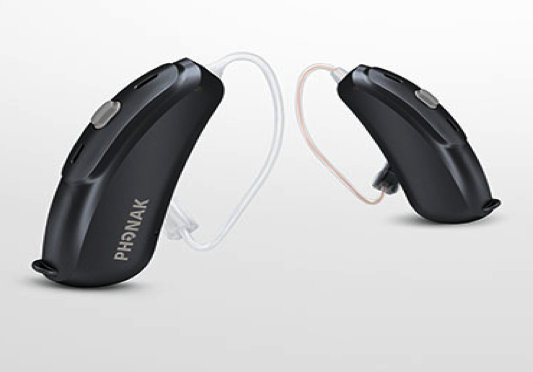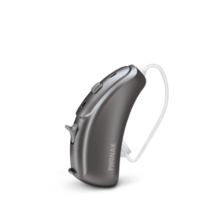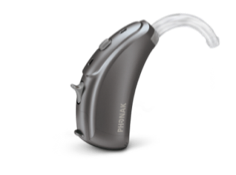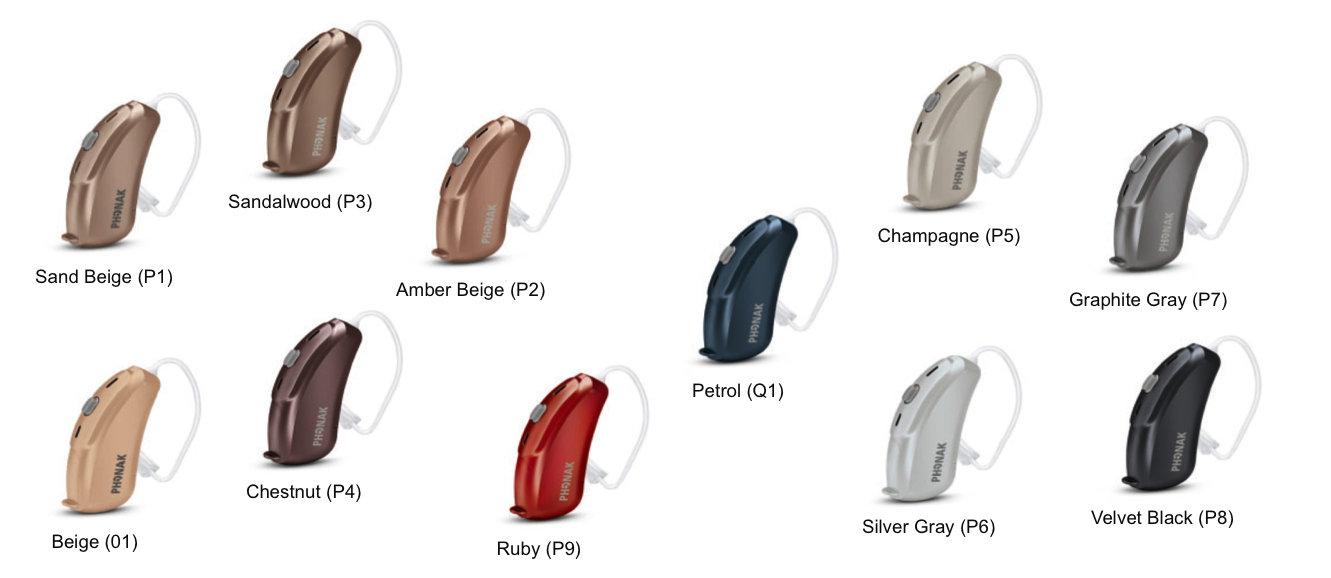Editor’s Note: This text course is an edited transcript of a live webinar. Download supplemental course materials.
Learning Objectives
At the conclusion of this course, you will be able to describe the different wireless CROS and Bi-CROS solutions available from Phonak, describe the candidacy for both CROS and Bi-CROS fittings, and describe how to perform a first fitting of Phonak CROS in the Phonak Target fitting software.
One Problem: Many Names
Single-sided deafness (SSD) is a medical term for total hearing loss in one ear that is unaidable and normal or near-normal thresholds in the opposite ear. Other names for this disorder include unilateral sensorineural hearing loss, total deafness in one ear, unaidable ear, total hearing loss in one ear, among others. For this presentation, we will be using the terms single-sided deafness or SSD, but be aware that clients might be used to other terms or consider themselves to have single-sided hearing loss when speaking about their hearing problem. Know that any of those terms all mean the same thing: one unaidable ear and normal hearing or aidable hearing loss on the other side.
CROS and Bi-CROS
CROS and Bi-CROS are nonsurgical solutions for SSD. There is a transmitter on the unaidable ear and a receiving hearing aid with or without amplification on the other ear. CROS stands for contralateral routing of signal, while Bi-CROS stands for binaural contralateral routing of signal.
Phonak introduced a CROS solution in 2011 that was based on its 10.6 MHz wireless technology. The Phonak CROS solution did not need any additional wires, which was a significant advancement at that time. The Phonak CROS system (transmitter, receiver and microphones) was also able to stream bidirectionality in real time with a full audio bandwidth between the two hearing aids. Today, it is a fully flexible wireless transmitter that can be combined with wireless Phonak Spice and Quest hearing aids.
Phonak CROS has been successful in the market with over 130,000 Phonak CROS devices sold in 2011. To put this in perspective, three years leading up to 2011 when we came out with the CROS, we sold 4,000 to 5,000 a year. With the launch in 2011, we saw our CROS sales triple. We set a different standard when our CROS was released.
CROS II
Today I am introducing the Phonak CROS II, the successor of the Phonak CROS. Like Phonak CROS, the Phonak CROS II requires a transmitter aid on the unaidable ear and a Venture hearing aid fitted to the better ear. This does mean that the CROS II is only compatible with Venture hearing aids going forward.
The Phonak CROS II comes in two discrete models of Audeo V housing (Figure 1). There is a CROS II-312 and the CROS II-13. They are compatible with all performance levels including V30, which is a huge win for Venture technology. Previously, it was only levels 50 through 90. It now has StereoZoom, easy fitting and demonstration, water resistance, 30% longer battery life and flexible volume options.

Figure 1. Phonak CROS II.
The original CROS was an omnidirectional hearing aid with an omnidirectional CROS transmitter. The information was received in an omnidirectional beam and then transferred to an omnidirectional hearing aid. This did not preserve the pinna effect with the unaided ear as well as with the BTE in omni.
With the Venture CROS II, have the CROS II transmitter and RealEar Sound transferring information over to the CROS Venture hearing aid that also uses RealEar Sound. That means that we are able to preserve the pinna effect. To people with normal hearing, it is similar to cupping your hand behind your ears. It does have a mild amount of directionality when you look at the software of RealEar Sound.
At the heart of these hearing aids and CROS II, we have Phonak’s newest chip, Venture, which is like the engine of the hearing aid. It provides twice the processing power than its predecessor and also features significantly lower power consumption while streaming. This means that users can enjoy the benefit of binaural voice streaming technology and streaming with lower battery drain, which is incredible when we start talking about CROS hearing aids, because they are streaming information constantly.
We are building on the success of the Phonak CROS. The Phonak CROS with Quest and Spice+ did use binaural voice stream technology. It had great water resistance, which we have integrated into CROS II. It is easy to fit and it has improved performance in noise with the use of StereoZoom.
Housing
The CROS II-312 and the CROS II-13, known before as the CROS and CROS H2O, have been named differently. The new CROS II housing is based on the slim design of the Audeo V. Phonak CROS II-312 and the CROS II-13 use the same Audeo V-312 and V-13 housing. The CROS II-312 has an IP rating of 57. This means it is dust protected and water resistant, and it has a push button only. The CROS II-13 BTE has a 13 battery with an IP rating of 67. It is dust tight and water resistant. It also has a push button and includes volume control. All CROS II housing is constructed with a composite material that is reinforced with 20% fiberglass. It is a fiberglass-nylon composite, which is a more robust housing than the previous CROS.
Coupling
A coupling option now included for the CROS II is a DemoHook (Figure 2) for all CROS devices as well as the new CROS II Hook for the CROS II-13 housing. The CROS DemoHook now replaces the universal CROS Retention. It has the same purpose, which is to demonstrate how the CROS II looks in the ear. The new hook will be shipped with all CROS devices including the previous generation Phonak CROS and Phonak CROS H20. The DemoHook should only be used as a temporary solution.

Figure 2. CROS DemoHook.
The current CROS retention is no longer available and has been removed from the portfolio. For a more permanent and long-lasting solution, the CROS SlimTube (Figure 3) can be used for an instant fitting; be sure to order the CROS SlimTube and not a SlimTube for a Bolero, for example, because they attach differently. The Slim Tip is still available and can be used with all CROS BTE transmitters.

Figure 3. CROS SlimTube
Finally, there is a new permanent solution for more retention with the CROS II Hook (Figure 4), and this is available for only the CROS II-13. It is an ear hook that can be attached to a traditional ear mold for the SSD client who wants a little more retention in the ear, but note that it cannot be attached to the CROS H20. It uses a pin assembly similar to other ear hooks.

Figure 4. CROS II Hook.
Battery Consumption
Battery life is a large concern for these devices, because the wireless back-and-forth streaming takes a lot of power. Up until now, battery life was more limited. The Venture chip has now provided up to a 30% battery improvement which translates to Phonak CROS II devices as well.
The 312 model can give up five days of battery life, and the CROS II-13 can give up to eight days of battery life. If you pair the 13 with a V13 on the other side, you can get up to 10 days of use out of that battery, which is significant for CROS users.
We have the use of StereoZoom in the CROS II, so we looked at how that impacted battery life. StereoZoom is a constant streaming between the two ears to create a narrower beam. We wanted to make sure this feature would not impact the battery life for CROS, and it does not. So CROS II users can now enjoy the benefits of StereoZoom.
Quest vs. Venture
With the Quest CROS, the Phonak CROS transmitter was in omnidirectional and it transmitted to a Phonak Quest hearing aid. That Quest hearing aid was in RealEar sound in a quiet environment. The Quest CROS in noise used RealEar Sound on the CROS side and transmitted that information to a Phonak Quest hearing aid as the receiver. That receiver used UltraZoom, our speech-in-noise program, to process that information. The information that was transferred over and adapted by the UltraZoom that was tied to that level technology; 50, 70, and 90. It was difficult to explain to patients why they may want a higher level of technology on the other side, especially if it was a CROS situation where they did not have hearing loss on that side. The reason we wanted a higher level of technology on the hearing aid ear was because of the superior UltraZoom functioning with that adaptability.
So how does Venture CROS II in noise differ from the previous CROS? As I mentioned, we are now using adaptive StereoZoom. The Phonak CROS II that is using the adaptive StereoZoom is transferring the information over to a Phonak Venture hearing aid, which is also using the same adaptive StereoZoom. This obviously gives you a better understanding in a noisy situation.
Adaptive StereoZoom is available when you pair the CROS II transmitter with a V90 or a V70 hearing aid. At the V70 level, that will be a manual push button function, and at the V90 level, it will happen automatically. That CROS II device wirelessly sends the audio signal in real time to the receiver in the better ear.
At the 50 level, it is in RealEar sound on the transmitter side and then uses the V50 UltraZoom on the receiver, which has now six points of null with Venture. The Phonak CROS II is now compatible with the V30, which uses an omnidirectional microphone on the CROS side, sent over to a Phonak Venture 30 on the hearing aid side in RealEear sound. The CROS II automatically varies the selected performance level on the hearing aid side. It is now easy to explain the different levels of CROS II technology to your patients.
What process flow is there for StereoZoom activation in AutoSense OS when coupling it with a CROS II system? With the V90 devices, this is automatic through binaural VoiceStream technology. It needs to detect speech in noise 80% of the time in at least two of its microphones, and in the other two, a noise floor of 58 dB SPL. Once all of those criteria line up for 15 seconds, it will activate automatically the StereoZoom. If one of those criteria drops out, then it will move into a different program.
Color Options
The CROS II is available in the same colors as the Bolero V and the Audeo V (Figure 5).

Figure 5. Phonak CROS II colors.
If you have a Venture product, you would need to pair it with a CROS II technology, versus Spice+ and Quest products which still have to be used with the CROS or CROS 13 H20. To remind you, Spice+ and Quest CROS technologies are offered on the 50, 70 and 90 levels, whereas with the Venture technology is offered at V30 through V90.
Volume and Mute Functions
The new push button and volume toggle allow the user to do a variety of things. A long press on that push button attenuates the Phonak CROS II side by up to 30 dB. This would act more as a mute function. Patients who have had difficulty in noise and do not necessarily want the CROS active in a noisy situation can attenuate it without having to remove it.
With the volume toggle, they can adjust the balance between the CROS and the hearing aid themselves. Previously, this could only be done in the software.
Because we have a CROS signal and a hearing aid signal, you can make the buttons do a variety of things. In the Target software, we give you a diagram that is printable for the patient that indicates what each button is doing. You can have the button on the hearing aid side adjust the hearing aid or the CROS adjust the CROS. There are some good volume options there.
There are two volume modes: CROS Volume and Volume. CROS Volume changes only the CROS signal. Volume mode changes the entire system volume, meaning both the hearing aid and the CROS volume. With the push button, each device will perform a different function for volume. If CROS Volume is selected, the CROS button will turn CROS volume up while the hearing aid button will turn CROS volume down. When Volume is selected, the CROS device will make the overall system softer, while the hearing aid button will make the overall system louder.
If you have the toggle on both hearing aids, it gives you more options for changing programs and volume, depending on what you want each button or toggle to do.
Fitting
We approached fitting the CROS II with a more simplified fitting approach. We suggest that you use an iCube II because you can instantly demonstrate the Phonak CROS II this way. Previously, you had to make adjustments and then turn it on to let the patient hear what it sounds like. You do not have to do that anymore. It is immediate, which is helpful for demo purposes.
Audiogram and upgrades. Prior to your first fitting with CROS II or the iCube II, there is a mandatory firmware upgrade for the Target software version 4.1. Step one with an iCube II is entering in the audiogram for the better ear only. Detect and connect the devices using the recommended fitting device, which is the iCube II. It will automatically set up the CROS II with an unaidable ear and the hearing aid to the better ear. There is no need to choose CROS or Bi-CROS fittings anymore. The Target software will do this for you.
If you previously fit an Audeo V and are creating a CROS II system with that device, there will be a mandatory firmware upgrade for the Audeo V device as well. That will allow the Audeo V to be compatible with the CROS II. The Bolero does not require this upgrade. The good thing about upgrades is that you do not have to do it unless you are fitting it with the other device, and you can do it easily during the fitting. Once you have done it, you do not need to do it again.
Binaural fitting. Step two is fitting like a traditional binaural session. Some of us get anxiety about fitting a CROS when we have not fit one for a while. The nice thing about this is that it is exactly like fitting a binaural fitting. There is nothing different about fitting a CROS. You simply put the devices in the neckloop and detect them. Once you link the binaural fitting between the CROS and the hearing aid, you run the feedback test. Then you can always use AudiogramDirect to make changes if you need to.
Under Basic Tuning is where you would adjust the balance and overall volume of the CROS fitting. You can present an acoustic sound in the left ear and in the right ear to test if the loudness levels are the same to the patient. I usually say the days of the week, asking if it sounds balanced in both ears. Remember that the CROS balance can be adjusted by the patient if they have the volume toggle set independently from the software, too.
Fine-tuning. You can add more programs if needed. Remember, if you pair the CROS II with a V70 on the other side, the StereoZoom is available only as a manual program, so you would have to put in a manual program for the V70 in order to access StereoZoom.
You can also turn the CROS transmitter off in certain situations. If the patient is an existing CROS user and they do not feel like they want the CROS active in quiet situations, you can turn that off for them, too. Your options are off, omni, and RealEar sound.
Device options. Checking out device options is the final step before saving. This is where you can set what your push button and volume toggle options will be. Once you decide those, you can save and close.
The Phonak CROS II is streaming while fitting if you use the iCube II, which is the recommended device. This instantly shows the benefit of the binaural VoiceStream technology, a CROS II demo situation, and it allows for faster balancing for the CROS system between the CROS II and the hearing aid. Make sure that it says “microphone is active” for the patient to hear the changes.
Another nice feature is that we now have a real-time display. This shows the signal is present, so if you were to talk on the CROS side, you would see it show both the hearing aid and the CROS side picking up.
Venture Performance Levels
Phonak Venture with the CROS II is available with all levels of technology, 30 through 90 (Figure 6). On the feature sheet in Figure 6, you will notice some of the features have a line through them; this is because those features are not available with the CROS. These features are Duophone, Speech in 360, and Speech in Wind. They are unavailable because they require hearing in both ears for full effect. StereoZoom, however, is highlighted because it is available in the V70 as a manual program and in the V90 as an automatic feature.

Figure 6. Phonak Venture performance levels with CROS II.
Summary
Today we discussed the updated features of the new CROS II, that will provide your patient a more seamless hearing experience. It is one of the smartest solutions available for SSD as a nonsurgical option. The CROS II is available in CROS II-13 and the CROS II-312.
Cite this Content as:
Cantin, A. (2016, January). Phonak CROS II. AudiologyOnline, Article 16190. Retrieved from https://www.audiologyonline.com

